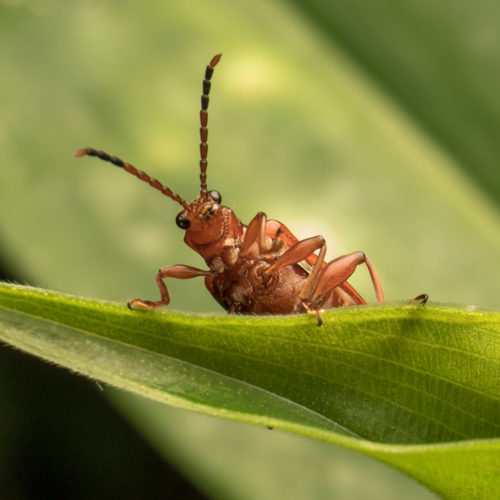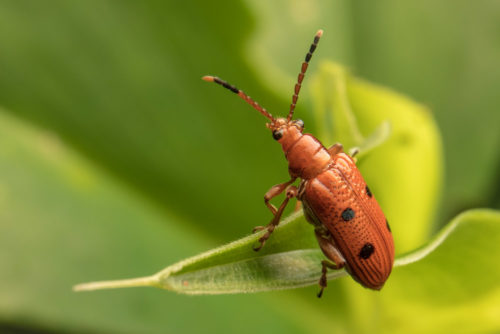
I saw this leaf beetle in my backyard feeding on the leaves of the Cheilocostus speciosus (Crepe Ginger). It has 4 tiny dark spots on their hard wing cases (elytra), two on each elytron. This corresponds to the description by Martin Jacoby back in 1908 The Fauna of British India V1: Coleoptera, Chrysomelidae, this beetle was identified as Lema cf. quadripunctata. I captured this Lema leaf beetle with Canon EOS-5D Mark IV with Canon EF 24-70mm f/4L IS USM. For illumination I used Godox Ving V860C II E-TTL Li-ion Camera Flash fitted with a homemade DIY softbox.

Several sightings confirm that Cheilocostus speciosus is indeed its host plant as the beetle was consistently found on this plant. While feeding on the leaves, the beetle makes a lot of small holes on the leaves, which indicate of its presence. However, there are usually just one or a few beetles around the vicinity.

The insects of the beetle family Chrysomelidae are commonly known as leaf beetles, and include over 37,000 species in more than 2,500 genera, making up one of the largest and most commonly encountered of all beetle families.

Leaf beetles are partially recognizable by their tarsal formula, which appears to be 4-4-4, but is actually 5-5-5 as the 4th tarsal segment is very small and hidden by the 3rd. As with many taxa, there is no single character that defines the Chrysomelidae; instead, it is delineated by a set of characters. Some lineages are only distinguished with difficulty from longhorn beetles (family Cerambycidae), namely by the antennae not arising from frontal tubercles.

Adult and larval leaf beetles feed on all sorts of plant tissue, and all species are fully herbivorous. Many are serious pests of cultivated plants, for example the Colorado potato beetle (Leptinotarsa decemlineata), the asparagus beetle (Crioceris asparagi), the cereal leaf beetle (Oulema melanopus), and various flea beetles, and a few act as vectors of plant diseases.

Others are beneficial due to their use in biocontrol of invasive weeds. Some Chrysomelidae are conspicuously colored, typically in glossy yellow to red or metallic blue-green hues, and some (especially Cassidinae) have spectacularly bizarre shapes. Thus, they are highly popular among insect collectors.

The imagos of leaf beetles are small to medium-sized, i.e. most species range from 1 to 18 mm in length, excluding appendages, with just a few larger species such as Alurnus humeralis which reaches 35 mm. The bodies of most species are domed, and oval in dorsal view (though some are round or elongate), and they often possess a metallic luster or multiple colors. In most specimens the antennae are notably shorter than the head, thorax and abdomen, i.e. not more than half their combined length. The second antennal segment is of normal size (which differentiates leaf beatles from the closely related longhorn beetles).

In most species, the antennal segments are of a more or less equal shape, at most they gradually widen towards the tip, although some Galerucinae in particular have modified segments, mainly in males. The first segment of the antenna in most cases is larger than the following ones. The pronotum of leaf beetles varies between species. In most, it is slightly to highly domed and trapezoidal to rounded-squarish in dorsal view. In some subfamilies such as the Cassidinae and to a lesser extent the Cryptocephalinae, the head is covered by the pronotum and thus not visible from above. The first three sternites are not fused, instead of being linked by mobile sutures. Most species possess wings, although the level of development and thus flight ability varies widely, including within a single species, and some are flightless with fused elytra.

